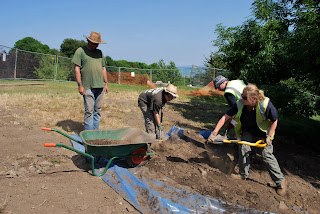 The report on the environmental samples taken from the soil filling the possible medieval ditch around Oystermouth Castle has just been returned to the office.
The report on the environmental samples taken from the soil filling the possible medieval ditch around Oystermouth Castle has just been returned to the office.The results are both puzzling and disappointing and show the soil to be relevantly clean, containing miniscule amount of charcoal and a very small amount of unidentifiably biological material (and lots of pebbles). The soil from medieval ditches tends to be very dirty. So does this mean there was no ditch? Where we just unlucky and happened to sample a very clean area of the ditch? Was the ditch regularly cleaned-out when open and filled back in with remarkably clean soil? (Most unlikely!) Or was it opened and backed-filled quickly with the same material, meaning the soil was fairly clean? (In which case the ditch wouldn’t have served a defensive purpose but could have been for foundations or quarrying.)
I’m beginning to wonder if the ditch (assuming it existed) ran around the bottom of The Tump, which was used as an outer bailey.
What do people think?









